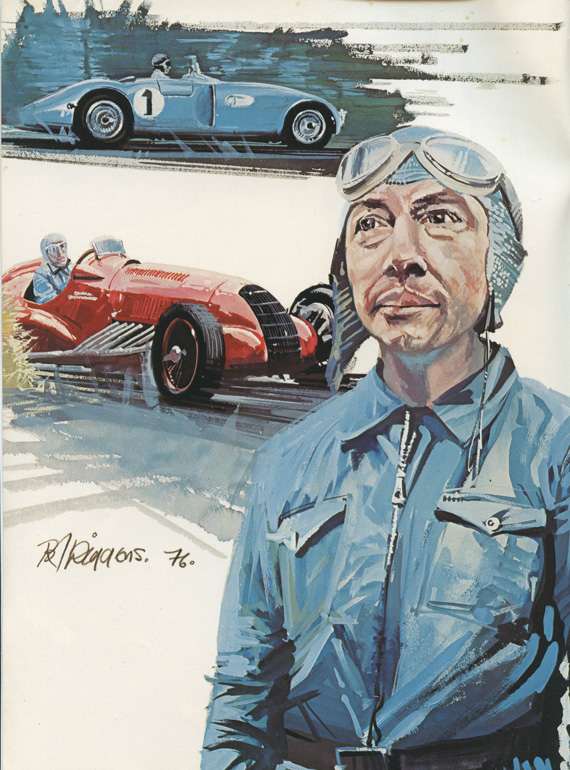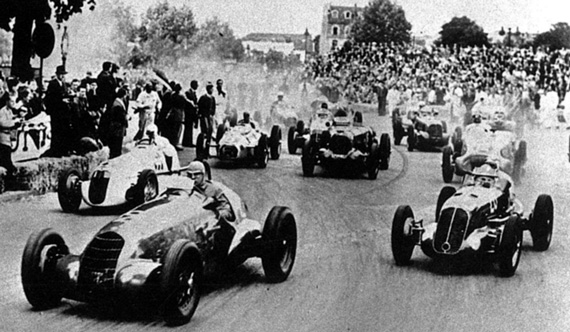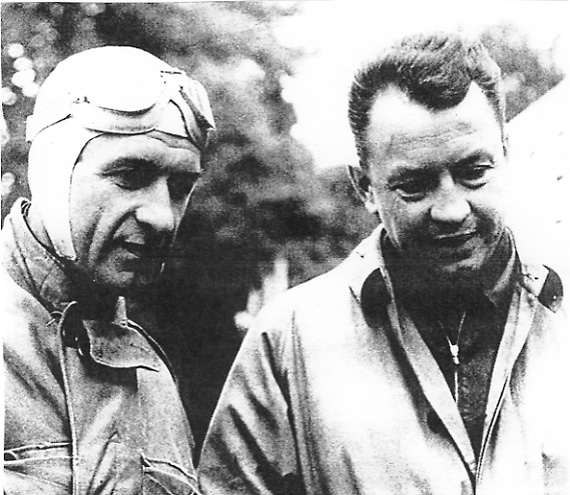By Clyde Berryman
There was more racing to take place in the Bois de Boulogne in the years following the 1945 event. The coupe de la Resistance on May 30, 1946 shaped up to be a promising re-match between Wimille and Sommer.
May 30, 1946 Coupe de la Resistance
This time, the race was to be held on a different circuit layout up in the northeast corner of the Bois near the Porte Maillot. Each of the main protagonists was now driving a different car: Wimille an Alfa-Romeo 308, while Sommer was back behind the wheel of a Maserati. Official qualifying had been introduced and the duel took on added interest as Sommer won pole position while Wimille qualified right alongside him in the center of the front row. The legendary Tazio Nuvolari, obviously now well past his prime, was sixth on the grid in a Maserati entered for him by Scuderia Milano, and another famous pre-war veteran, Louis Chiron, was further down in a Talbot.
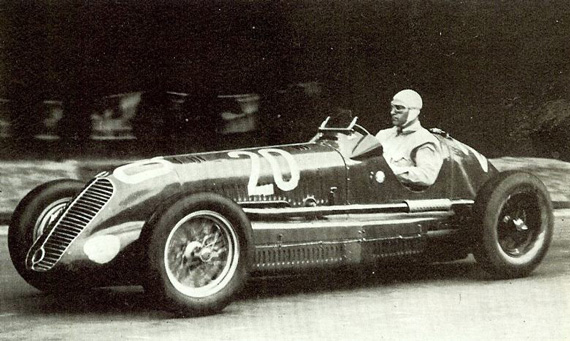
Sommer in his Maserati on May 30 1947. He would finish seventh due to gearbox problems. Photographer unknown.
At the start, Sommer fought Wimille for the lead and had tenuously wrested control by the end of the first lap. Nuvolari must have gone off the mark like cannon in order to close up into third behind them. A few laps later, Sommer over-cooked it trying to keep ahead and spun, stalling the engine in the process. He was illegally push-started by some well-meaning spectators (unnoticed by the race officials) but his gearbox would hamper him for the rest of the race, dropping him to seventh place. Nuvolari’s gearbox too had seized, putting him out of the race early on. Wimille cruised home to another Bois de Boulogne victory with venerable Louis Chiron in second place a minute behind.
October 6, 1946 Coupe du Salon
Poor Raymond Sommer finally did get his well-deserved victory in the Bois that fall at the 6 October Coupe du Salon race staged on the Porte Maillot-based circuit. Although he won by the huge margin of three laps, the win was missing one element which would have made it a far more satisfying triumph: Wimille was not present! Alfa Romeo had promised Jean-Pierre one of their new 158 “Alfetta’s” but the new Formula One regulations now in vigor precluded its entry.
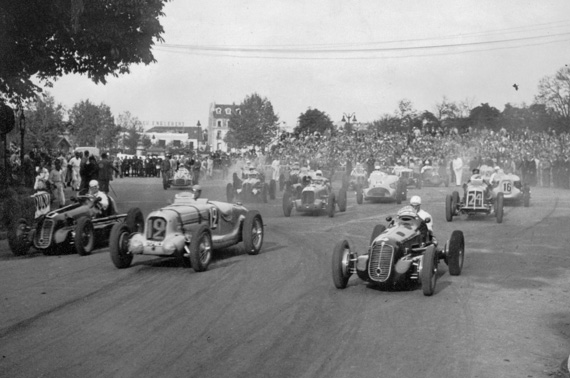
The grid gets away for the Coupe du Salon on October 6 1946. Far left, Henri Louveau in a Maserati 4CL, a charging Talbot Lago of Pierre Levegh, and on the pole was Raymond Sommer and his Maserati 4CL. Sommer won but Wimille did not enter. Photo courtesy Grand Prix Library
There was an accompanying 23-lap “voiturette” race the same day, the Coupe Robert Mazaud, named in honor of the prominent French racing driver who was killed at Nantes in July. He had swerved to avoid hitting Louis Gerard and ended up somersaulting his own Maserati. This Coupe Mazaud was actually a much closer contest than the Coupe du Salon, with Eugene Martin in a BMW 328 winning over Auguste Veuillet in an MG. By the way of speed comparisons at this time, the voiturette cars were running about 10 mph slower around the course than their larger-engine Grand Prix counterparts.
July 27, 1947 Coupe de Paris
The only motor race in the Bois in 1947 was the Coupe de Paris, also a voiturette race run on 27 July, but it had the merit of again bringing together the two perennial French rivals, Jean-Pierrre Wimille and Raymond Sommer, for another much anticipated head-to-head clash. Further, as if to add spice to the contest, they would both be driving Simca-Gordini’s for Equipe Gordini, which was also lining up cars for Maurice Trintignant and Prince Igor Troubetskoy.
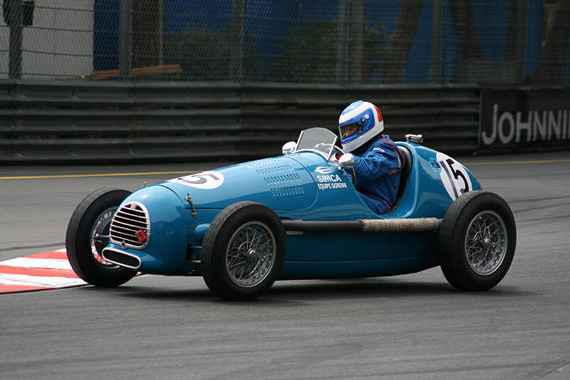
Troubetskoy used this Gordini, 2-GC 1100 to place fourth in the second race. Photo by Hugues Vanhoolandt at Monaco.
The event consisted of two qualifying heats of 20 laps each and a final of 35 laps on still a different course layout in the Bois which this time, went around the Longchamp hippodrome. The crushingly torrid temperatures that day were in the 36-40 degree Celsius range. The first heat, for 2 liter un-supercharged and 1.1 liter supercharged cars, saw Charles de Coranze, driving an unusual Peugeot, inherit the win.
The second heat, for 1.1 liter un-supercharged cars, was faster and more exciting; as all the Simca-Gordini cars were running against one another and a couple of Cisitalia D46’s entered by Lucy O’Reilly Schell for her son Harry and Raymond de Sauge.
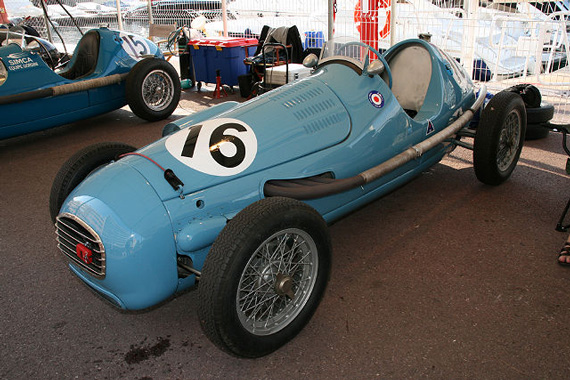
Raymond Sommer did not have a great time in the 1947 Longchamps race. Here is his car, 6 GC T15 at a recent Monaco event. Photo by Hugues Vanhoolandt.
As could be expected, a fierce wheel-to-wheel battle developed between Sommer and Wimille. Sommer had qualified fastest with a lap of 2’14.3” against Wimille’s 2’16”, and he barely held onto the lead until lap 16 when a cylinder head gasket blew. As Sommer’s car was deemed un-repairable in time for the race finale, Amedee Gordini decided to give him Trintignant’s car while Trintignant took over Troubetskoy’s.
For the first twenty laps, Wimille and Sommer again had the enthralled crowds on their feet, repeatedly passing one another and lowering the lap record which finally went to Sommer with a 2’15.2” (78.7 mph). On Lap 21, Sommer struck a curb and then smashed the back end of his Gordini. A hasty pit stop was not enough to repair the more-serious-than-thought damage and Sommer struggled home to sixth place, again witness to the frustrating spectacle of yet another Wimille win.
Sadly, within three years, these two rugged individualists, both survivors of the French Resistance and of countless race mishaps, would be dead. For Jean-Pierre Wimille, the end came on January 28, 1949, during practice for the General Juan Peron Grand Prix at Palmero Park, Buenos Aires. In an accident still shrouded in mystery, Wimille’s Simca-Gordini struck the hay bales placed at the track’s edge and was launched into a tree trunk. Jean-Pierre died of serious head and chest injuries during the ambulance ride to the hospital.
As to Raymond Sommer, he was driving a Cooper (graciously loaned to him by Harry Schell) in the 1950 Grand Prix de Haute Garonne at the Cadours Circuit when he crashed and was killed. A memorial was erected beside the spot on the road where he died. Just as with the death many years later of the great Jim Clark in a minor Formula Two race at Hockenheim, it was a tragic irony that both Wimille and Sommer respectively perished in events which were considered of secondary importance in their day.
May 20, 1951 Grand Prix de Bagatelle
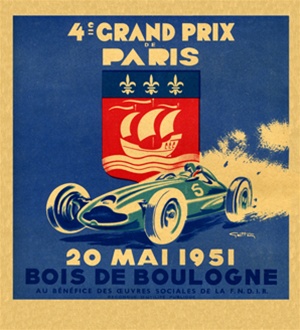 Robbed of France’s two great champions, the last-ever grand Prix motor race to be held in the Bois de Boulogne on May 20, 1951 was going to take on an entirely different character. It was a non-championship Formula One race (1.5 liter supercharged, up to 4.5 liter un-supercharged) run in parallel to the World Driving Championship which had already been formally inaugurated in 1950. It is sometimes referred to in contemporary accounts as the Grand Prix de Bagatelle, as the competitors would have to cover 125 laps of a 2.5 kilometer circuit around the gardens bearing that name near the Chateau de Madrid. The key protagonists this time were the reigning World Champion, Giuseppe “Nino” Farina in a “San Remo” Maserati, and sensational Juan-Manuel Fangio who had come to Europe from Argentina in 1948. Driving for Equipe Gordini on this occasion, Fangio was also Farina’s teammate in the works Alfa-Romeo team and his most serious rival in the concurrent World Driving Championship. It was Swiss Baron Emmanuel “Toulo” de Graffenreid in the other Maserati 4CLT who created the surprise by grabbing Pole Position with a 1’19.2” lap. Andre Simon even qualified his Gordini ahead of Fangio who only managed seventh fastest time.
Robbed of France’s two great champions, the last-ever grand Prix motor race to be held in the Bois de Boulogne on May 20, 1951 was going to take on an entirely different character. It was a non-championship Formula One race (1.5 liter supercharged, up to 4.5 liter un-supercharged) run in parallel to the World Driving Championship which had already been formally inaugurated in 1950. It is sometimes referred to in contemporary accounts as the Grand Prix de Bagatelle, as the competitors would have to cover 125 laps of a 2.5 kilometer circuit around the gardens bearing that name near the Chateau de Madrid. The key protagonists this time were the reigning World Champion, Giuseppe “Nino” Farina in a “San Remo” Maserati, and sensational Juan-Manuel Fangio who had come to Europe from Argentina in 1948. Driving for Equipe Gordini on this occasion, Fangio was also Farina’s teammate in the works Alfa-Romeo team and his most serious rival in the concurrent World Driving Championship. It was Swiss Baron Emmanuel “Toulo” de Graffenreid in the other Maserati 4CLT who created the surprise by grabbing Pole Position with a 1’19.2” lap. Andre Simon even qualified his Gordini ahead of Fangio who only managed seventh fastest time.
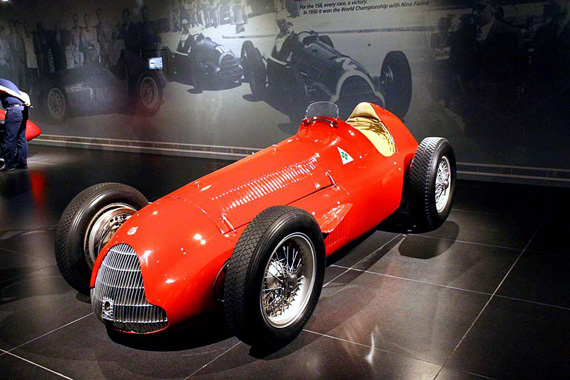
The 158/59 Alfa would change Grand Prix racing, while both Fangio and Farina would win World Championships with the car. Roberto Motto photo.
There was reportedly some friendly “point of honor” rivalry going on within the Gordini camp after Fangio had taken Robert Manzon’s car out onto the track for practice and lapped it more than three seconds faster than Manzon! The race got underway at four and immediately, Manzon sought to make a statement by taking command of the race ahead of Farina, but this lasted only ten laps. Then, it was Fangio’s turn to inevitably surge past Manzon into second place and the battle with Farina began in earnest. On Lap 23, Fangio seized the lead in an audacious, full-bravado passing maneuver.
Alas, glory would be short-lived as mechanical failures started to befall the entire Gordini team, one after the other, during the rest of the afternoon. Fangio, forced to pit on Lap 34, returned to the fray in combative form, and was staging a remarkable comeback until a spin on Lap 66 left him stalled and out of the race. An imperial Farina smoothly motored on to claim the winner’s laurels ahead of the bulky Argentinian driver Froilan Gonzalez, Frenchmen Louis Rosier, Henri Louveau, the veteran Etancelin, and Pierre Levegh who were all driving 4.5 liter Talbot-Lago’s.
By year’s end, Fangio would have the last word over Farina by clinching the 1951 World Driving Championship. However, the Bois de Boulogne now became history as far as motor sports were concerned. The French racing authorities had an understandable preference for making use of the purpose-built Montlhéry track south of Paris or increasingly, they would look toward the fast road circuit at Reims in the Champagne countryside as the preferred venue.
Note: Clyde Berryman lives in Williamsburg with his wife Gulay. Guly’s new Williamsburg Art Gallery will open soon and offer some great Michael Turner prints. For details click here: Williamsburg Art Gellery
